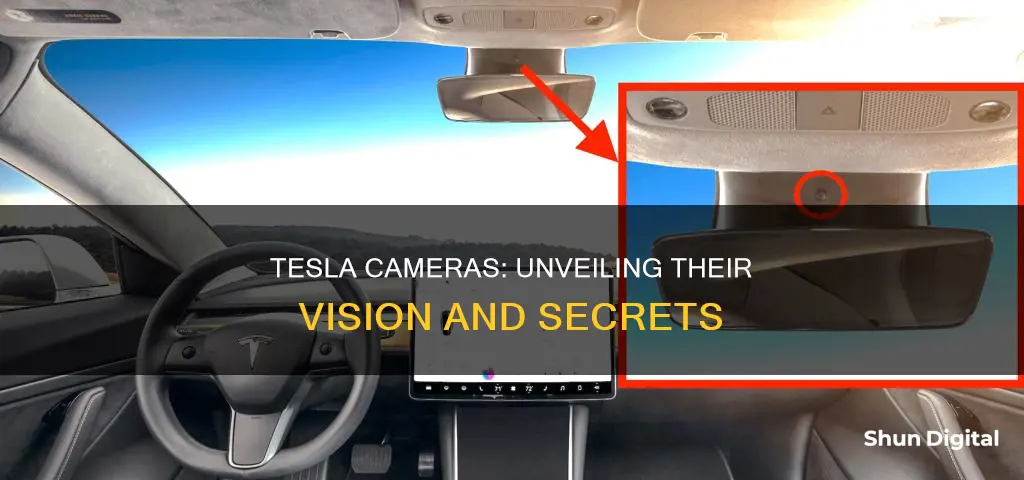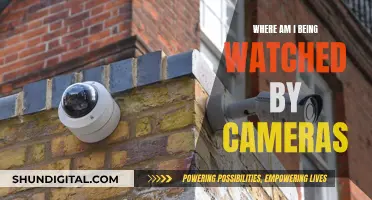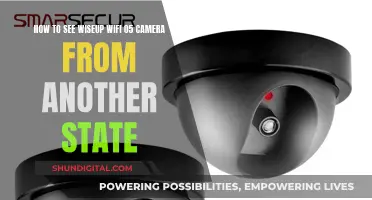
Tesla's camera systems are designed to enhance safety, enable autonomous features, and provide security against threats. The cameras are strategically placed around the vehicle, with models such as the Model 3, Model Y, and the redesigned Model S and Model X featuring nine cameras. The front cameras are located at the top of the windshield and consist of a camera with a typical lens, a wide-angle lens, and a telephoto lens. The telephoto camera can see up to 250 meters ahead, while the main lens covers 150 meters. The rearview camera assists with parking, reverse driving, and automatic emergency braking, providing a view of up to 50 meters behind the vehicle. Additionally, cameras on the fenders help monitor the vehicle's blind spots, and side cameras on the B-pillar capture areas in the front half of the vehicle. All current Tesla models also include a cabin camera located above the rearview mirror, which monitors driver attentiveness, especially when Autopilot is in use. These camera systems play a vital role in enhancing vehicle safety and providing driver-assist features, contributing to Tesla's mission of shaping the future of sustainable transportation.
| Characteristics | Values |
|---|---|
| Number of Cameras | 8-9 |
| Camera Locations | Above rear license plate, each door pillar, above rearview mirror, each front fender, on the windshield |
| Camera Functions | Enhance safety, enable autonomous features, provide security, monitor driver attentiveness, assist with parking, reverse driving, and automatic emergency braking |
| Camera Calibration | Requires highly-visible lane markings in driving lane and adjacent lanes; calibration typically completes after driving 20-25 miles but varies depending on road and environmental conditions |
| Camera Maintenance | Keep cameras clean and free of obstructions; do not use chemical-based or abrasive cleaners |
What You'll Learn

Tesla cameras monitor driver attentiveness
Tesla's camera systems are designed to enhance safety, enable autonomous features, and provide security against threats. The cameras are strategically placed around the vehicle, and their functionality has evolved significantly over the years.
All current Tesla models include a cabin camera located above the rearview mirror to monitor driver attentiveness, especially when Autopilot is in use. The camera can determine driver inattentiveness and provide audible alerts to remind the driver to keep their eyes on the road. The system can detect when the driver is not paying attention, such as when they turn their head or close their eyes, and will provide alerts accordingly. The cabin camera does not perform facial recognition or any other method of identity verification, and Tesla assures its customers that their privacy is of utmost importance. By default, images and videos from the camera remain in the vehicle and are not transmitted unless data sharing is enabled by the user.
In addition to the cabin camera, Teslas have several other cameras placed around the vehicle. These include front-facing cameras, a rearview camera, cameras on each fender, and side cameras on the B-pillar. These cameras assist with various functions such as parking, blind-spot monitoring, navigation at complex intersections, and automatic emergency braking.
Simultaneously Viewing Vivint's Dual Cameras: A Step-by-Step Guide
You may want to see also

Cameras assist with parking
Tesla's camera systems are designed to enhance safety, enable autonomous features, and provide security against threats. The cameras assist with parking in several ways.
Firstly, Tesla's camera systems include a rearview camera positioned above the license plate. This camera provides a view of up to 50 meters behind the vehicle, assisting with parking, reverse driving, and reverse automatic emergency braking. The rearview camera is complemented by a camera on each front fender, pointing towards the rear of the vehicle at a 45-degree angle. These fender cameras assist with parking by allowing the vehicle to see vehicles to its side and monitor blind spots.
Additionally, Tesla vehicles include two side cameras on the B-pillar, facing towards the front of the vehicle. These cameras aid with parking by capturing areas in the front half of the vehicle, including complex intersections and tight curves. When driving at low speeds, the driver can switch to the Park Assist view on the touchscreen, which utilizes these cameras to provide assistance with parallel parking.
The Park Assist feature uses cameras mounted on the front, rear, and sides of the vehicle to create a high-fidelity reproduction of surrounding objects on the touchscreen. The visualization uses colours to indicate the distance between the car and objects, with red indicating closer objects and yellow indicating objects that are farther away. When reversing, the touchscreen displays visual feedback, and audible beeps sound as the vehicle approaches an object.
It is important to note that Park Assist has limitations and may not function correctly in certain situations, such as when cameras are damaged, dirty, or obstructed, or when objects are too close or too far from the cameras. Therefore, it is crucial to always inspect the area with your own eyes and not solely rely on Park Assist.
To ensure optimal performance of the camera systems, it is essential to keep the cameras clean and free of obstructions. Regular cleaning and maintenance of the cameras will help prevent issues and ensure their effectiveness in assisting with parking and other safety features.
Apple Watch Series 3: Camera-Equipped or Not?
You may want to see also

Cameras help with reverse driving
Tesla's camera systems play a pivotal role in enhancing safety, enabling autonomous features, and providing security against threats. The rearview camera, for instance, is positioned above the license plate and provides a view of up to 50 meters behind the vehicle, making reversing safer and more precise.
When the driver shifts into reverse, the touchscreen automatically displays the view from the rearview camera. Lines on the screen indicate the driving path based on the position of the steering wheel, which adjusts as the wheel is turned. This feature is designed to guide the driver and improve safety, but it is not a substitute for careful driving and performing shoulder checks. The camera's performance can be affected by a variety of external factors, including a dirty or obstructed lens, so it is important to ensure the lens is clean and clear before driving.
In addition to the rearview camera, Tesla vehicles also have cameras on the fenders that point towards the rear of the vehicle at a 45-degree angle, aiding with blind spots and parking. These cameras can be viewed by the driver when using the blind spot monitor feature or by enabling the side cameras while reversing.
Tesla's continuous updates have improved the clarity and functionality of the rearview camera, including enhanced white and color balance, and the removal of the trunk and bumper from the video feed to provide a clearer, more centralized perspective of the environment behind the vehicle.
The camera systems in Tesla vehicles are strategically placed to enhance the driving experience, with a focus on safety and autonomous features. The rearview camera, in particular, plays a crucial role in assisting with reverse driving and ensuring a safer driving experience.
Vine Camera: Reliving the Vines
You may want to see also

Cameras aid with monitoring blind spots
Tesla's camera systems are strategically placed around the vehicle to enhance safety, enable autonomous features, and provide security against threats. The cameras play a vital role in the advanced features the vehicles are known for, such as the Autopilot system and active safety features like Automatic Emergency Braking (AEB).
The Automatic Blind Spot Camera feature in Tesla vehicles is designed to aid drivers in monitoring their blind spots and enhancing overall safety. When the turn signal is engaged, the touchscreen displays the image from the corresponding side repeater camera, providing visibility into the vehicle's blind spots. This feature is especially useful when changing lanes or turning, as it allows drivers to see vehicles or objects that may be in their blind spots, thus helping to prevent accidents.
The blind spot camera can be turned on or off by accessing the Controls > Autopilot > Automatic Blind Spot Camera settings on the touchscreen. Once enabled, engaging the turn signal will display the image from the side repeater camera on the touchscreen. A vertical red bar appears on the image to warn the driver of a vehicle detected in their blind spot. For example, when the left turn signal is engaged and a vehicle is detected, a vertical red bar appears on the left side of the image.
In addition to the Automatic Blind Spot Camera feature, Tesla vehicles also have physical cameras mounted on the vehicle's fenders, which point towards the rear at a 45-degree angle. These cameras aid in monitoring the vehicle's blind spots and can be viewed by the driver using the blind spot monitor feature or by enabling the side cameras while in reverse.
It is important to note that while these camera systems provide valuable assistance, drivers should not solely rely on them and must still remain attentive and perform the necessary shoulder checks when changing lanes or turning.
Wyse Cameras: Live Viewing and Comprehensive Access
You may want to see also

Cameras help with navigating intersections
Tesla's camera systems are designed to enhance safety, enable autonomous features, and provide security against threats. The cameras are placed strategically around the vehicle, with some models featuring nine cameras, and others equipped with Hardware 4.0 (HW4), which have eight higher-resolution cameras and two front-facing cameras.
The front cameras on Tesla vehicles consist of a camera with a typical lens, a wide-angle lens, and a telephoto lens. The telephoto camera can see up to 250 meters ahead, making it ideal for high-speed Autopilot use, while the main lens covers 150 meters. Additionally, the wide-angle lens provides a panoramic-like view, which is extremely useful for navigation at complex intersections and tight curves. This feature aids drivers in maneuvering through intricate highway junctions and urban crossroads, making it easier for them to navigate challenging intersections.
The rearview camera assists with parking, reverse driving, and automatic emergency braking, providing a view of up to 50 meters behind the vehicle. Teslas also have cameras on each fender that point towards the rear at a 45-degree angle, helping to monitor blind spots and allowing the vehicle to see vehicles on its side.
Furthermore, Tesla vehicles include side cameras on the B-pillar, which are aimed towards the front of the vehicle. These cameras aid in capturing areas in the front half of the car and are particularly useful when navigating intersections and parking.
The camera systems in Tesla vehicles play a crucial role in enhancing safety, enabling autonomous features, and providing security. The strategic placement of these cameras allows for a comprehensive view of the vehicle's surroundings, making driving and parking safer and more convenient for Tesla owners.
Apple Watch Ultra: Camera Expectations and Realities
You may want to see also
Frequently asked questions
The cameras are designed to enhance safety, enable autonomous features, and provide security against threats. They aid with parking, driving in reverse, and monitoring the vehicle's blind spots. The cameras also play a vital role in Tesla's Autopilot system and active safety features like Automatic Emergency Braking (AEB).
The number of cameras varies depending on the model and year of the Tesla. Older models feature nine cameras, while newer models are equipped with Hardware 4.0 (HW4), which includes eight higher-resolution cameras and two front-facing cameras.
Cameras are strategically placed around the vehicle, including above the rear license plate, mounted to the windshield above the rearview mirror, on each door pillar or B-pillar, and on the front fenders.







